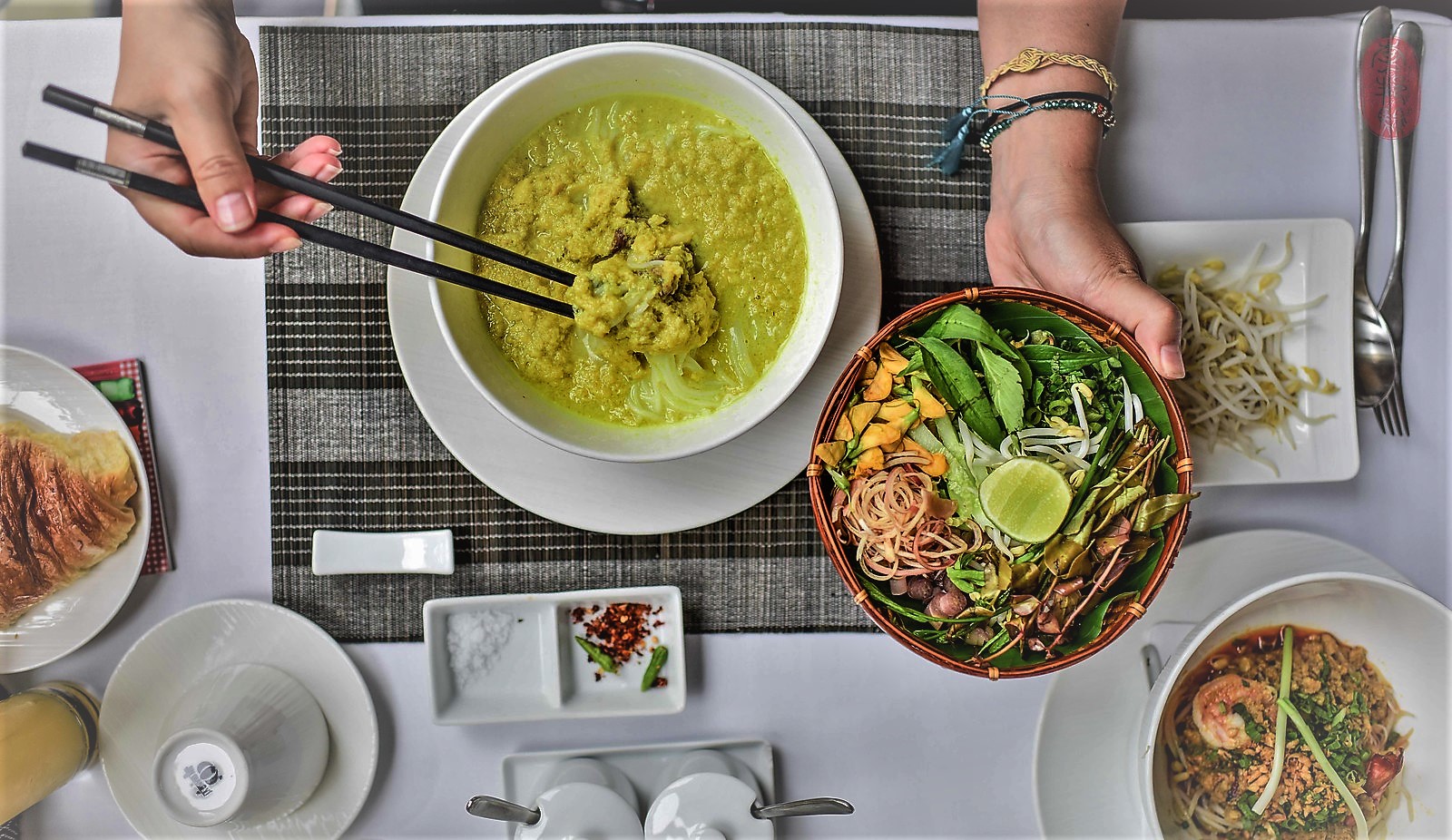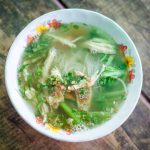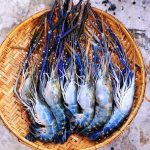Darren Gall introduces us to num banh chok, Cambodia’s famous and delicious rice noodle dish.
Cambodian’s are proud of their num banh chok, it is the name of their rice noodles and also the name of the enormously popular dish they are used in. Num banh chok can be found in every village of every province throughout the kingdom, with many having their own version of the dish, which can be eaten for breakfast, lunch, or as an afternoon snack.
The fermented rice noodles are served cold and topped with a light fish gravy, accompanied by fresh herbs, vegetables and green fruits. Typical accompaniments to num banh chok are snake beans, banana blossom, mint, basil, water lily and pickled cucumber.
Elders remember that the finest num banh chok once came from the province of Kampong Cham, where it is said the Mekong river fish had a particularly delectable flavour. They will also tell you that Cambodians have always made these noodles, back to the earliest days of civilisation.
How to Make Num Banh Chok Rice Noodles
The making of num banh chok noodles is a drawn-out and labour-intensive process: fermented rice is boiled, drained and then ground by stone mill. With the addition of a little water, the ground rice is worked into a stiff dough-like paste. The dough is wrapped in cloth and pressed under a heavy object, such as a large stone to remove excess water. The paste is then boiled once more, drained and then thoroughly pounded in a mortar and pestle until it has an elastic, springy texture. The dough will be further kneaded by hand and droplets of water added until it begins to take on the consistency of fresh meringue or thick, whipped cream, it is then finally ready to be turned into noodles.
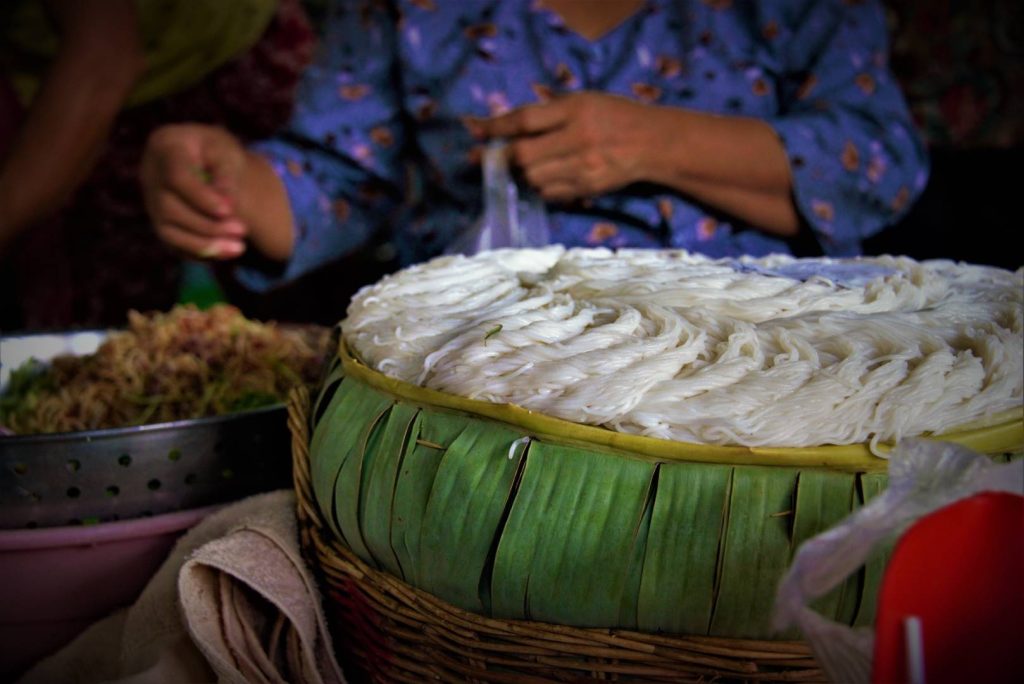

To turn the dough into noodles you then press it into a mold, (usually a large can) with sieve-like holes in one end that has been placed over a pot of boiling water. The dough is squeezed through the holes, in rural villagers to this day it is done by sitting on a wooden cantilevered contraption that looks a bit like a one-person see-saw, under this weight fresh noodles are forced out through the holes, stretching down into the boiling pot.
The noodles are quickly fetched from the boiling pot and placed into icy cold water before being drained and folded into the woven, green leaf baskets commonly seen at markets and food stalls all over the country.
Num Banh Chok Recipes
The noodles may be eaten with samlor Khmer (Khmer soup), samlor kary (Curry), or samlor namya, (a red curry also called samlor krohom) – all of which are variations of kroeung, spices and ground river fish. Some regions have their own famous versions of num banh chok. Siem Reap uses a lot of garlic and coconut milk and a special, sweet fish sauce known as tik-pha-em. Kampot num banh chok utilises the local dried shrimp, coconut cream, peanuts and fish sauce. In some areas, num banh chok is served with a curried chicken sauce made using shrimp paste and yams.
The Cambodian Cookbook of H.R.H. Princess Rasmi Sobhana, (1965) lists a royal version of num banh chok with a ‘crown’ sauce, made with chicken liver, Cognac, (brandy) and green peas.
The traditional recipes and preparations for num banh chokk have changed little over the centuries, rich or poor, young or old, town or village, no matter where you come from it has always been a favourite dish of Cambodian people and that is a story and a dish well worth sharing.
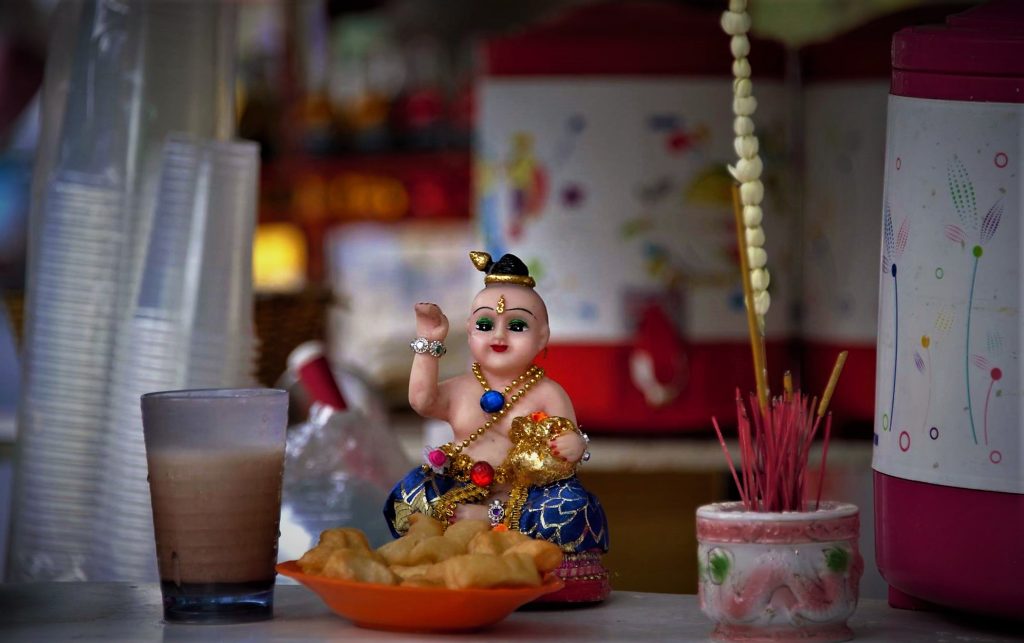

The Story Tellers
For as far back as anyone can remember Cambodians have always loved a good story and good storytellers were once famous, a bit like the pop and movie stars of today. After a hard day’s work in the fields or, after the harvest was completed lazy afternoons and long evenings would be spent with the village crowding around the storyteller’s platform to be regaled by their fantastic tales.
Some of the storytellers would play the traditional Chapei Dong Veng, chanting stories in rhyming verse and adding drama in all the right moments with the instrument. Stories could go on for many hours, slowly raising up the emotions of the audience, making them laugh then cry. Sometimes, when the weather was too hot, they would tell ghost stories to give the audience goose-bumps and the perception they had cooled down.
These poems, performances and stories all serve a purpose, whether that be for pure entertainment, education, propaganda or giving instruction on morals and virtue.
One of the enduring characters of Cambodian storytelling is that of the orphan boy, Thun Chey who in the words of my friend was ‘so smart that he was often stupid’. Thun Chey was always trying to outwit the rich and the powerful; he was a bit of a wise guy who would never listen because he always thought he knew better, he was impertinent, mischievous and quick to answer back. Thun Chey was considered too clever for his own good and seemed to always be getting himself into trouble, but then he always managed to somehow get himself out of it.
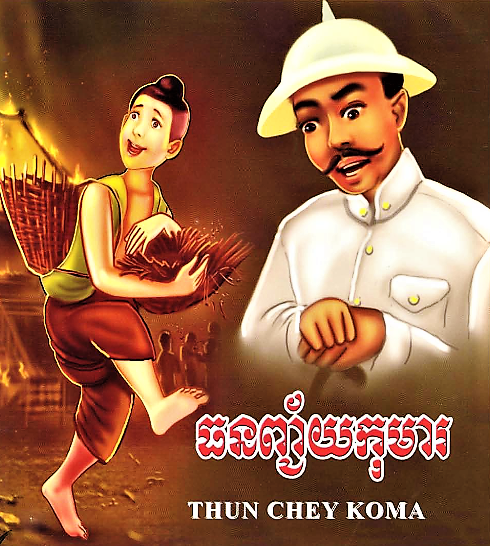

There are countless stories and lessons told and taught involving Thun Chey, known to most Cambodians since they were small children. As a colleague pointed out to me, although we may forget many of the stories, every one of us will recall Thun Chey as a part of our childhood. There are literally hundreds of tales about Thun Chey and his adventures in calamity, many survive to this day and are still taught in schools, recently there was even a film made about his adventures. A common saying in the Khmer language is to be told that ‘you are a real a-Chey!’ which means your behaviour resembles that of Thun Chey.
One of the most enduring stories is that of his trip to China and how he introduced noodles to the Chinese. The Khmer king became so fed up with Thun Chey he sent him into exile and Thun Chey was sent to China, having no money he began selling num banh chok noodles to the locals. According to the legend the Chinese had never eaten noodles before or certainly never anything as good as Thun Chey’s num banh chok and soon his dish was becoming famous all over the country. Eventually, the Emperor of China himself got wind of Thun Chey’s famous dish and sent for him to appear at the palace to prepare the dish so the Emperor might see what all the fuss was about.
Thun Chey was told he was forbidden from looking at the face of the emperor and must look down and kowtow at all times. Of course this only made Thun Chey more curious to steal a peek at the emperor’s face and when he tilted his head back to gulp down some noodles Thun Chey peered up and took a glance. Unable to contain himself he uttered the unfortunate words comparing the Emperor’s face with a dog’s derriere and his own King’s as that of a bright full moon. Predictably the Emperor overhead Thun Chey and immediately had him thrown in jail.
Thun Chey was finally released from the prison but remained in the palace, he built a kite that made the sound of a dove crying and flew it all night, the noise troubled the Emperor who summoned his fortune-teller, only to be told that if he did not let Thun Chey return to Cambodia the sound would drive him to despair and so Thun Chey was able to escape and eventually return to his homeland, Cambodia, where he continued to enjoy his num banh chok.
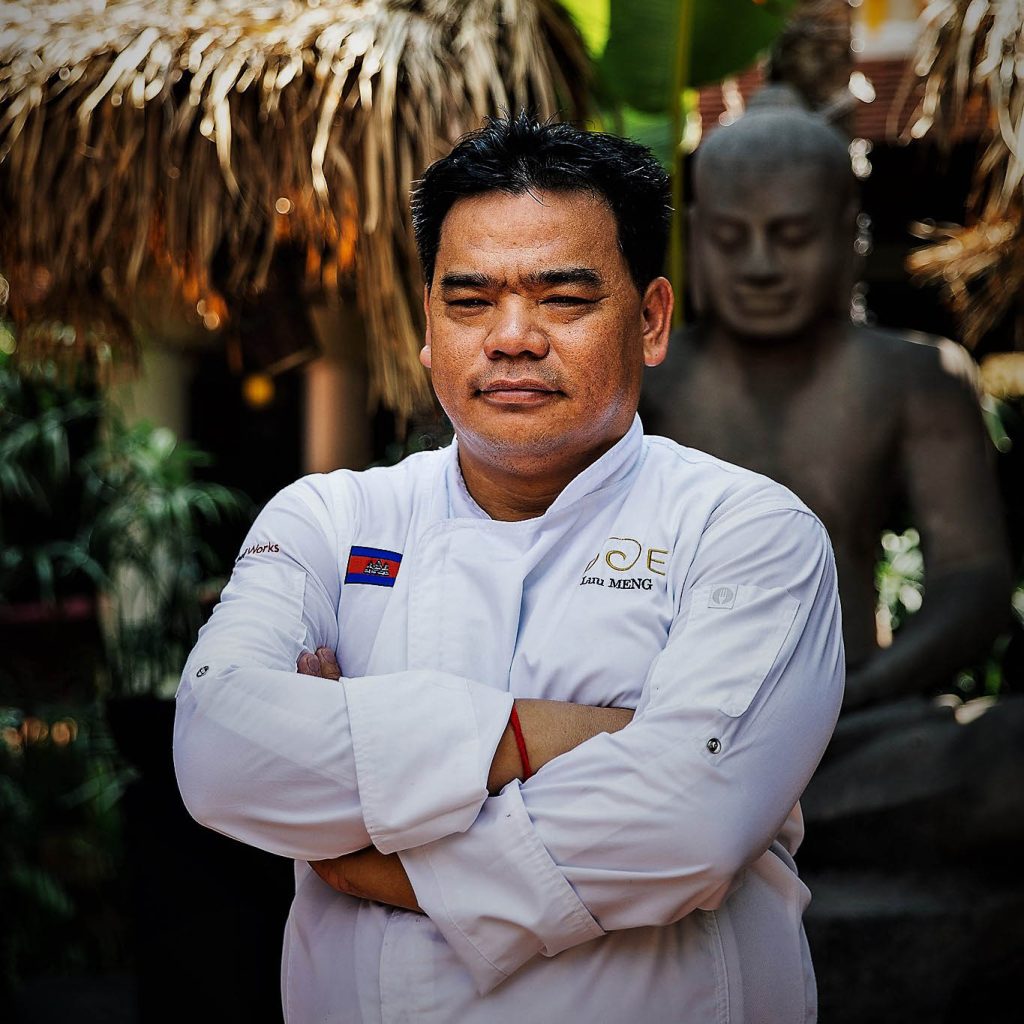

Master Chef Luu Meng
Luu Meng is Cambodia’s Master Chef, internationally he is Cambodia’s most recognisable chef and has regularly been visited by global celebrity chefs such as Gordon Ramsay and Anthony Bourdaine to name but two. Both locally and regionally, he has earned the respect and admiration of his peers.
Luu Meng has been honoured by the French government with the Ordre National du Mérite Agricole (National Order of Agricultural Merit, and has been or is currently the president of Cambodian Hotel Association, president of Cambodia Chef Federation, vice president of Asean Hotel Association, vice president of The China Hong Kong and Macao expatriate and business association of Cambodia and vice the Huang Zhao Association of Cambodia.
He is the author or co-author of several books on Cambodian cuisine and hospitality and regularly prepares meals for his King, Prime Minister, countless international dignitaries, movie stars, and business moguls. Luu Meng is regularly invited with the Cambodian Ministry of Tourism to promote Khmer cuisine around the globe and is always grateful to share the flavours, ingredients and cooking techniques of his homeland.
Luu Meng as a Director of Thalias Hospitality and the founding chef of Malis restaurant is constantly experimenting with flavours and textures and extracting his country’s culinary secrets – to be shared in the Malis kitchen and beyond.
I consider Meng a ‘culinary national treasure’, but most proudly, it makes me deeply happy to be able to call him my friend. And so it was -through this friendship – that I one day found myself belting down to Kampot ridiculously early one morning with Chef and our trusty photographer, determined to uncover the famous river town’s best num banh chok. Culinary raiders of lost recipes instead of lost tombs or arcs.
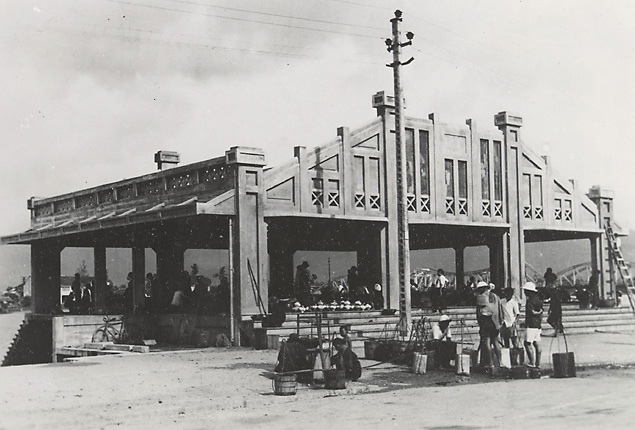

Num Banh Chok in Kampot
Kampot town still has that touch of nostalgic romance attached to it, an idyll, a sleepy town on a quiet river with early morning mist on the mountains nearby. The township has well-preserved with historical architecture, and a rich history of pirates, civil war, spirits, myths, and legends.
In 1840, King Ang Duong constructed a road from the then capital of Oudong, to Kampot, and opened it up as the only international seaport of Cambodia. Import and exports grew rapidly in the hands of the Anglo-Chinese merchants of Singapore, soon Kampot was a thriving trading port and a melting pot of multiculturalism.
An 1889 French colonial census reports, Kampot town consisted of “Cambodian Kampot” on the Prek-Kampot River and “Chinese Kampot” on the right riverbank of the west branch of the Prek-Thom River. Nearby was also a Vietnamese village, called Tien-Thanh and another Vietnamese village on Traeuy Koh Island. A Malay enclave also existed on Traeuy Koh Island. Additional villages of mixed ethnicity are also listed and it is noted that the local economy benefitted significantly from the cultivation of Kampot pepper.
Every region, enclave and village in the kingdom has its own special ‘Num Banh Chok’, based on local ingredients, tastes and techniques, passed down through oral history and born from the times of the ancients. Kampot num banh chok, incorporates locally-produced sweet dried shrimp, coconut cream, fish sauce and peanuts, as we approached the town, still half asleep in the passenger seat, I recalled my first encounter. Over a decade ago, deep inside the bowels of the old wooden Kampot market, amidst the smoke of clay ovens and the steam off cooking pots, the morning light coming in between the slats and cracks at funny angles, like beams, all adding to the dreamlike quality of my vision, an apsara in an apron, enchanting me with a fragrant, steaming bowl. Jolted awake as we entered the town the memories of flavours and smells still dancing with my emotions, I was ready to mount a determined search for the best this place had to offer, even if it took all day.
It took all day; scouring the streets and markets, reconnoitering with local connections and divining direction from local embellishment. In the end, the good people of Kampot settled on not one, but two places vying for the coveted title of best num banh chok, and to a man they all agreed, the one we wanted was the place with free wifi!
Turns out, it was the other place we wanted, a good distance out of town on some narrow dirt tracks, we went past it a few times before we found it; a small sala samnak – resthouse, on the front corner of a small plot, with a traditional Khmer stilt house, set at the back of the property.
At 4 pm each afternoon, the lady of the house comes out to produce her fresh noodles, the people come from all around to buy them and once the batch of paste runs out she stops. Under the raised floor of the rest-house was the familiar large pot of water over hot coals, above it the wooden press, in no time Meng was seated in this contraption pressing noodles straight into the boiling broth.
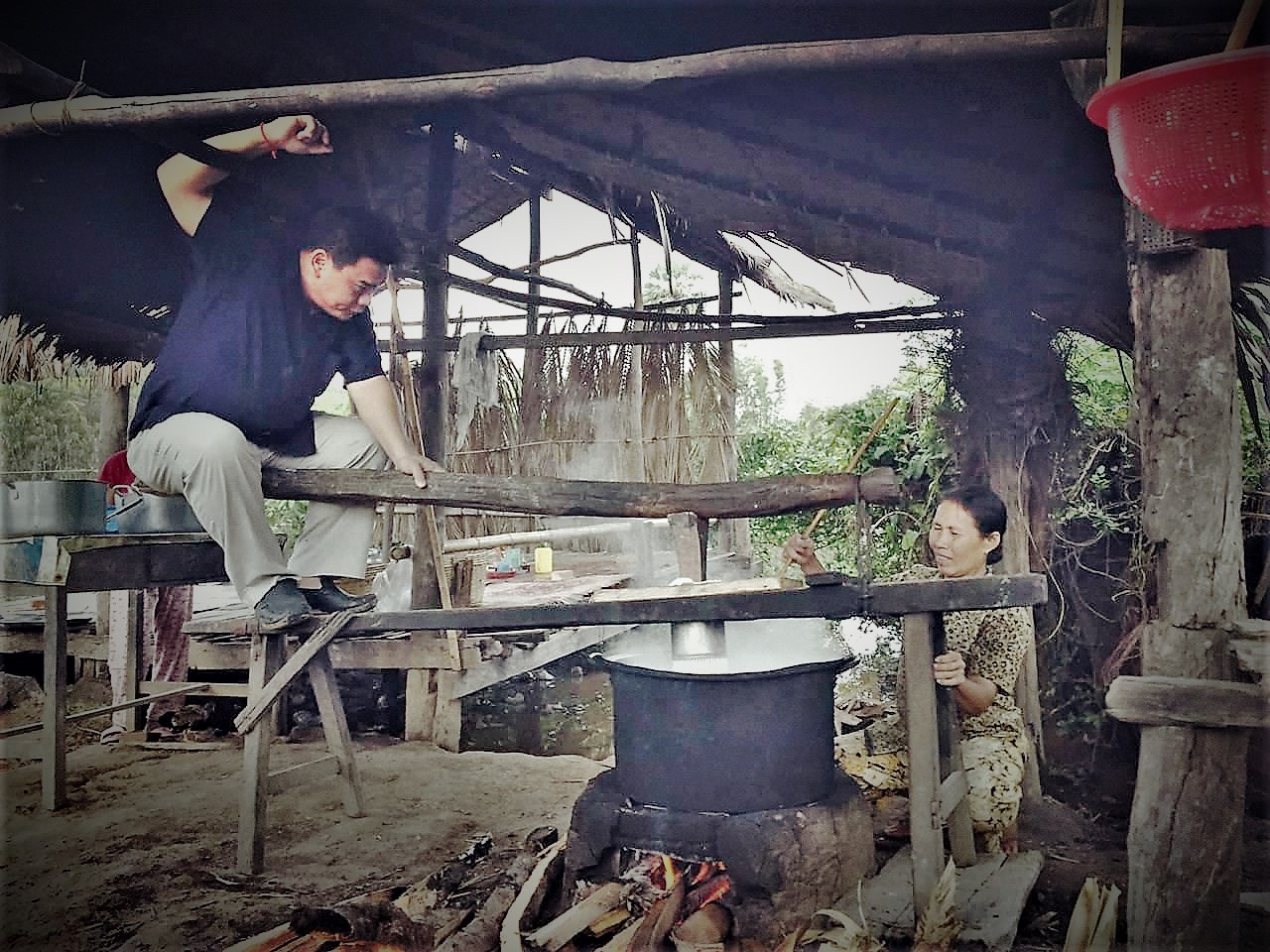

Fresh, exciting aromas were soon emanating from our steaming bowls, sublime, delicious; not just because of the ingredients but, because of the long and winding journey we had taken to finally get here, because we were out in the Cambodian countryside and meeting and talking to good people and sharing it with cherished friends because these are the days you live for and these were the flavours you hope to find.
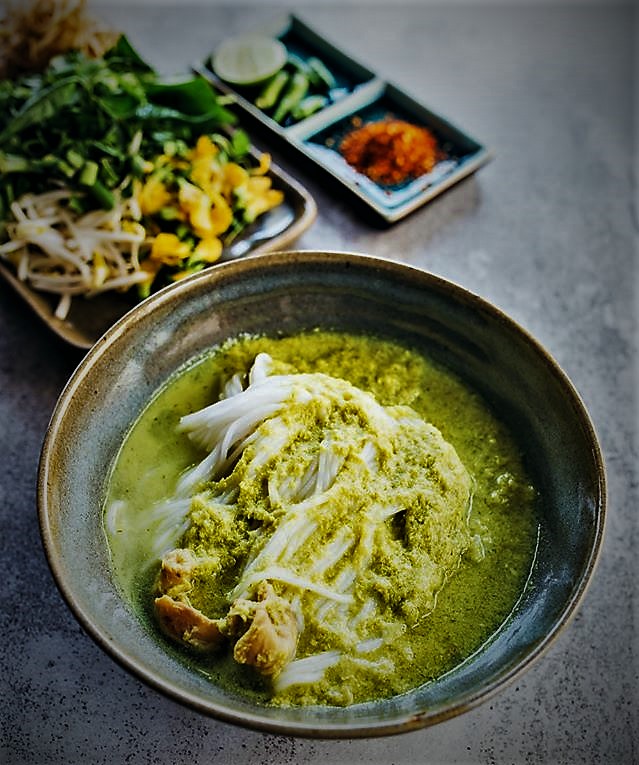

The Malis Num Banh Chok
Malis restaurant opened its doors in 2006, yet in truth, it is a restaurant born out of centuries of Khmer history, out of a lifetime in kitchens, learning, and cooking. Malis is the realization of the desire, passion, and a dedication to restore Cambodian cuisine to its former glory and put Cambodia back on the map as a culinary destination.
Renowned for its fresh seasonal produce, delicate flavours, and generous hospitality, Master Chef Luu Meng and his team, decided to revive Cambodian cuisine from the past, adapt it to the present, and preserve it for the future. Meng calls it ‘Living Cambodian Cuisine’ and it is here that Cambodians return and it is here that foreign guests seek out, so they may experience elevated Khmer dining in its highest forms.
For Luu Meng, num banh chok is a heritage dish, a dish for celebrations, a dish of the people, so popular and so common that it is both the name of noodles and of the dish itself. Meng simply describes it as Samlor Khmer.
Rice Noodles with River Fish Gravy
Meng also sees it as a dish that epitomises Malis, it has to respect its traditions and reflect the best quality of ingredients, technique, and know-how; reminding people of the glorious meals they enjoyed from their parents or grandparents in the past and also showing them the possibilities for local gastronomy when it meets the highest levels of quality and expertise.
Malis num banh chok takes hours to prepare, the broth, boiled slowly with local herbs, spices, and flowers as well as fish bones to concentrate its aromas and flavours. Many herbs, flowers, and spices go into the house Kroeung, the complex local version of a curry paste. Galangal, okra, shallots, lemongrass, kaffir lime rinds, two types of chilli, cucumber, mint, basil, and many more. The local river fish, Trei Ros is always used, plump, juicy, sweet of flesh it is boiled slowly, then most of it is added to the paste. Balance is key here, the sweet, richness of the fish, balanced by citrus, bitterness, subtle tannin and fine spice.
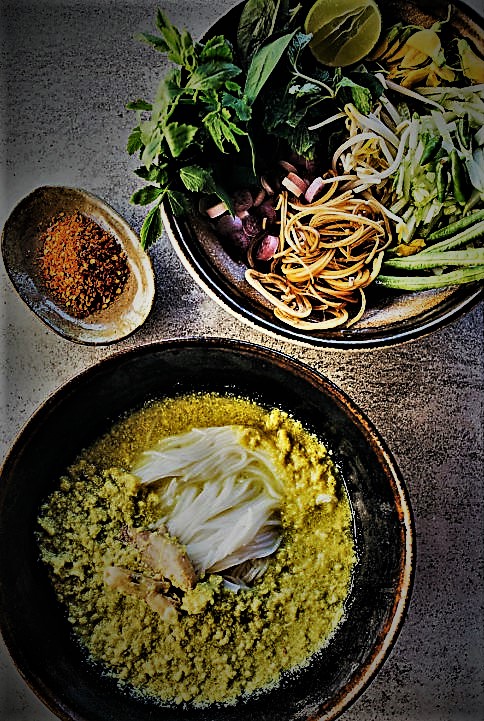

Most customers will eat num banh chok for breakfast, and Meng makes it a point that the Malis num banh chok is the perfect way to start your day.
This post originally appeared on Vindochine: https://www.vindochine.com/2021/11/16/num-banh-chok/
